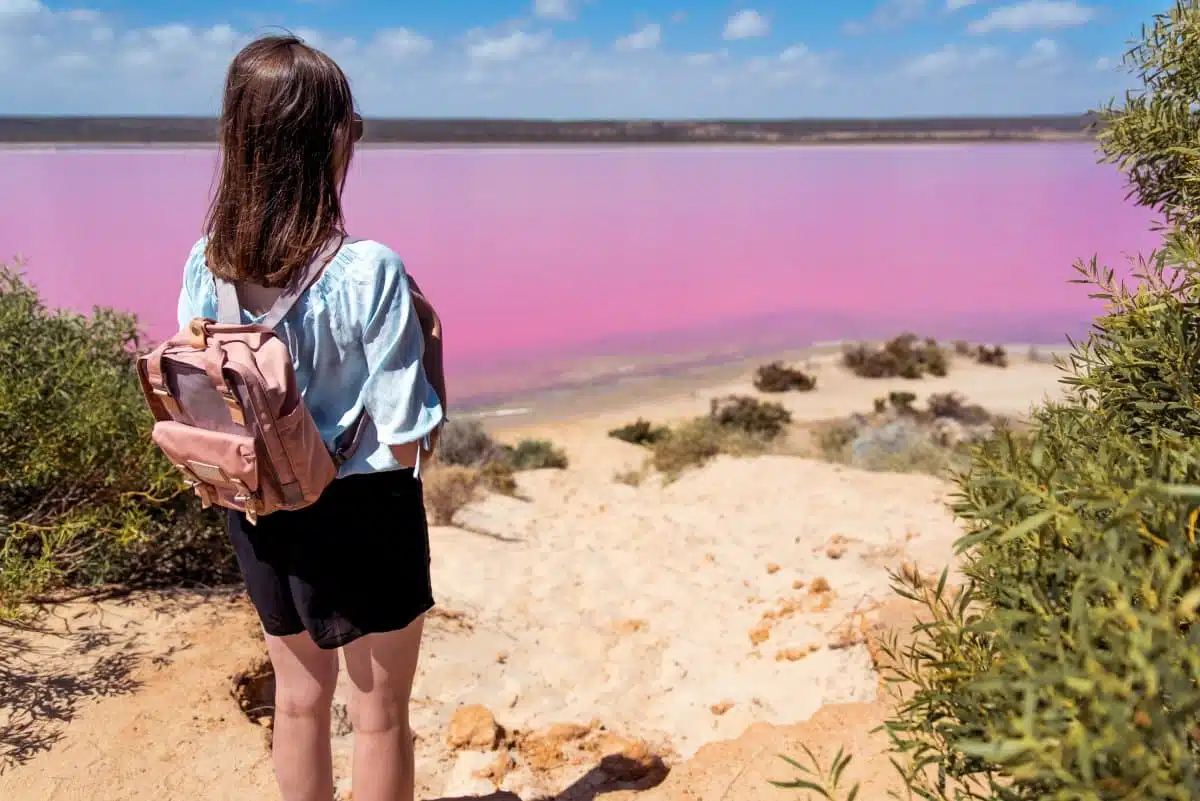Nature’s palette is vast and varied, but perhaps nothing is as strikingly unusual and captivating as the phenomenon of pink lakes. Scattered across the globe, these natural wonders draw visitors for their unique coloration and the intriguing scientific processes behind their hues. The pink color is typically due to certain algae, bacteria, and high salt concentrations interacting under specific conditions. This guide explores some of the most remarkable pink lakes worldwide. It offers insights into why they’re pink, how to visit them, and the best times to witness their surreal beauty.
1. Lake Hillier, Western Australia
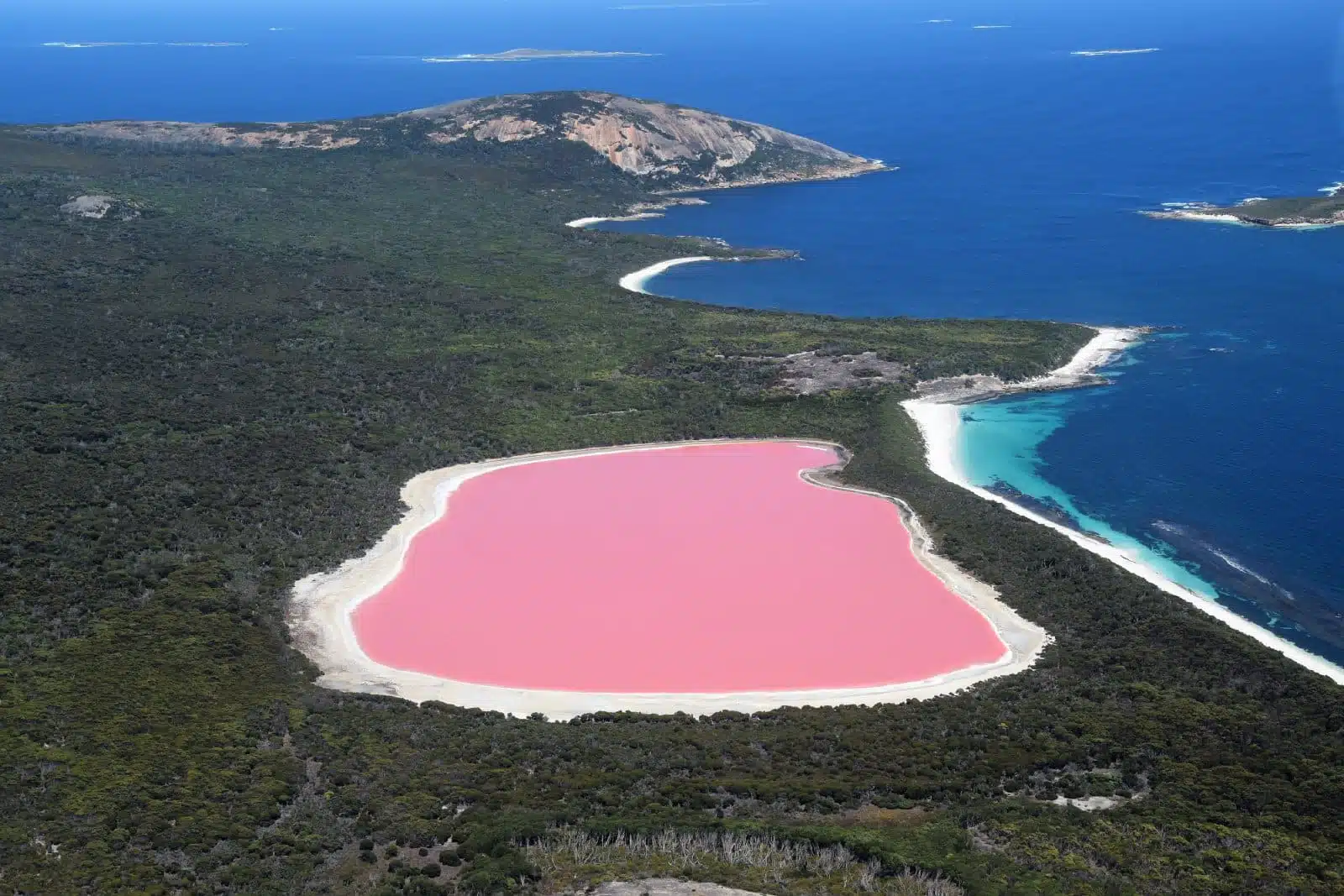
Image Credit: Shutterstock / matteo_it
Lake Hillier delights with its vivid pink hue, a stark contrast to the surrounding ocean’s deep blue and the forest’s lush green. This saline lake on Middle Island in the Recherche Archipelago remains one of Australia’s most mysterious natural wonders. Its coloration, attributed to the presence of Dunaliella salina algae and halophilic bacteria, creates a surreal landscape that captivates both scientists and travelers. Unlike many colored lakes that change hue with fluctuating conditions, Lake Hillier maintains its pink shade year-round, whether viewed up close or from above. The lake’s isolation adds to its magic, making it a prized destination for those seeking the extraordinary. A visit to Lake Hillier is an expedition to one of nature’s most stunning anomalies.
Insider’s Tip: The best views of Lake Hillier are from the air. Consider booking a scenic helicopter or plane tour for an unforgettable aerial perspective.
When to Travel: The Australian summer months of December to February offer the clearest skies for flights over the lake, though the region’s mild climate makes it accessible year-round.
How to Get There: Access to Middle Island is restricted to protect its delicate ecosystem, but scenic flights depart from nearby Esperance, offering a chance to see the lake from above.
2. Lake Retba, Senegal
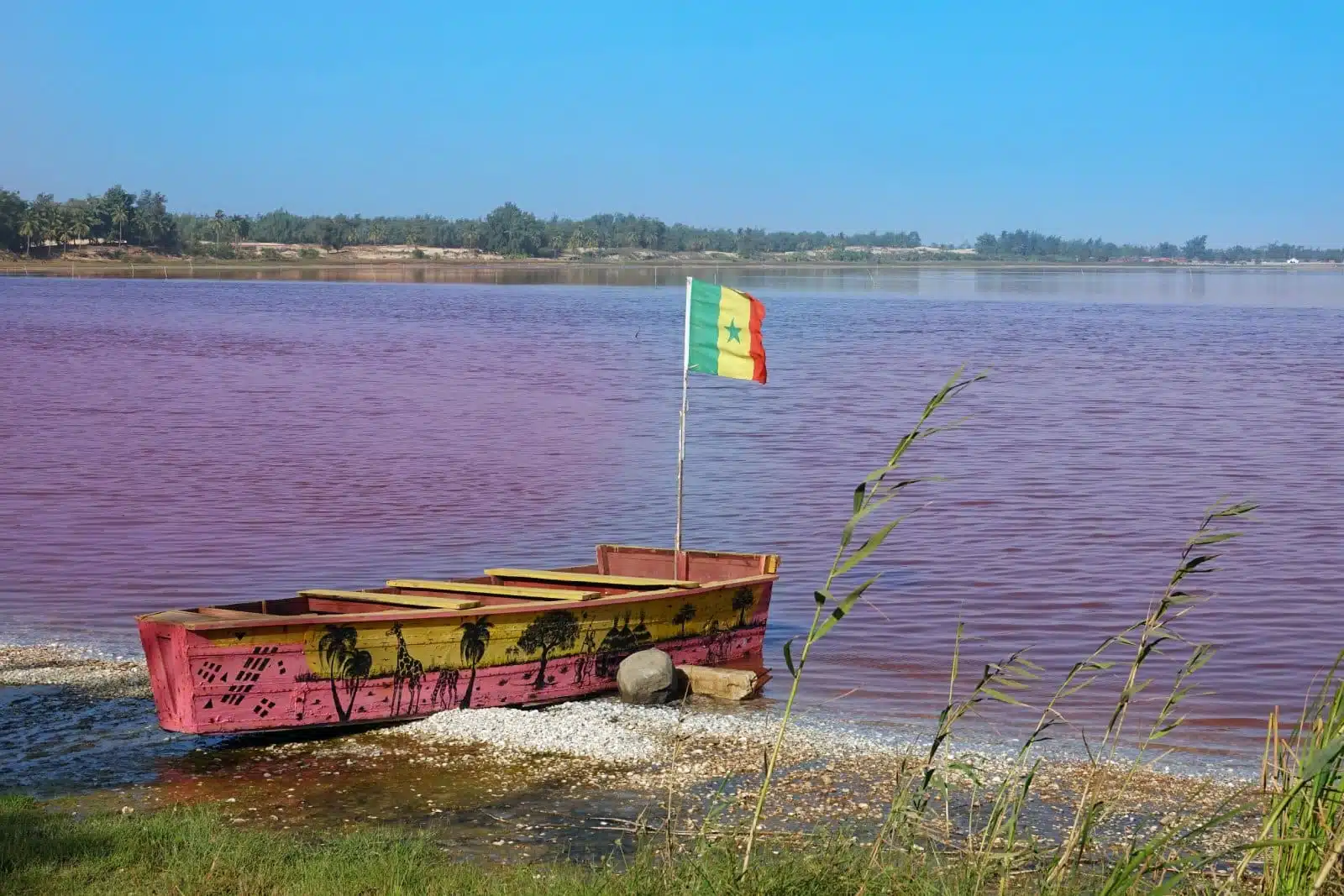
Image Credit: Shutterstock / Cyril PAPOT
Lake Retba, or Lac Rose, is less than an hour away from Senegal’s capital but feels worlds apart. Its rosy waters, edged by white salt banks and framed by the Senegalese savannah, offer a striking visual spectacle. The lake’s high salinity, comparable to the Dead Sea’s, allows for effortless floating, a novelty that attracts many visitors. The local salt harvesters, balancing on their boats and sculpting the salt from the lakebed, provide a human connection to this otherworldly landscape. The microorganisms thriving in Lake Retba’s waters are a source of scientific curiosity and livelihood for the surrounding communities, making the lake an intersection of natural wonder and human endeavor. Visiting Lake Retba offers an insight into the delicate balance between ecological uniqueness and economic necessity.
Insider’s Tip: Visit during the dry season when the pink color is most vibrant due to higher salt concentrations.
When to Travel: The best time to see Lake Retba at its pinkest is during the dry season, from November to June.
How to Get There: Lake Retba is easily accessible by car from Dakar, with the journey taking approximately an hour.
3. Las Coloradas, Yucatan, Mexico
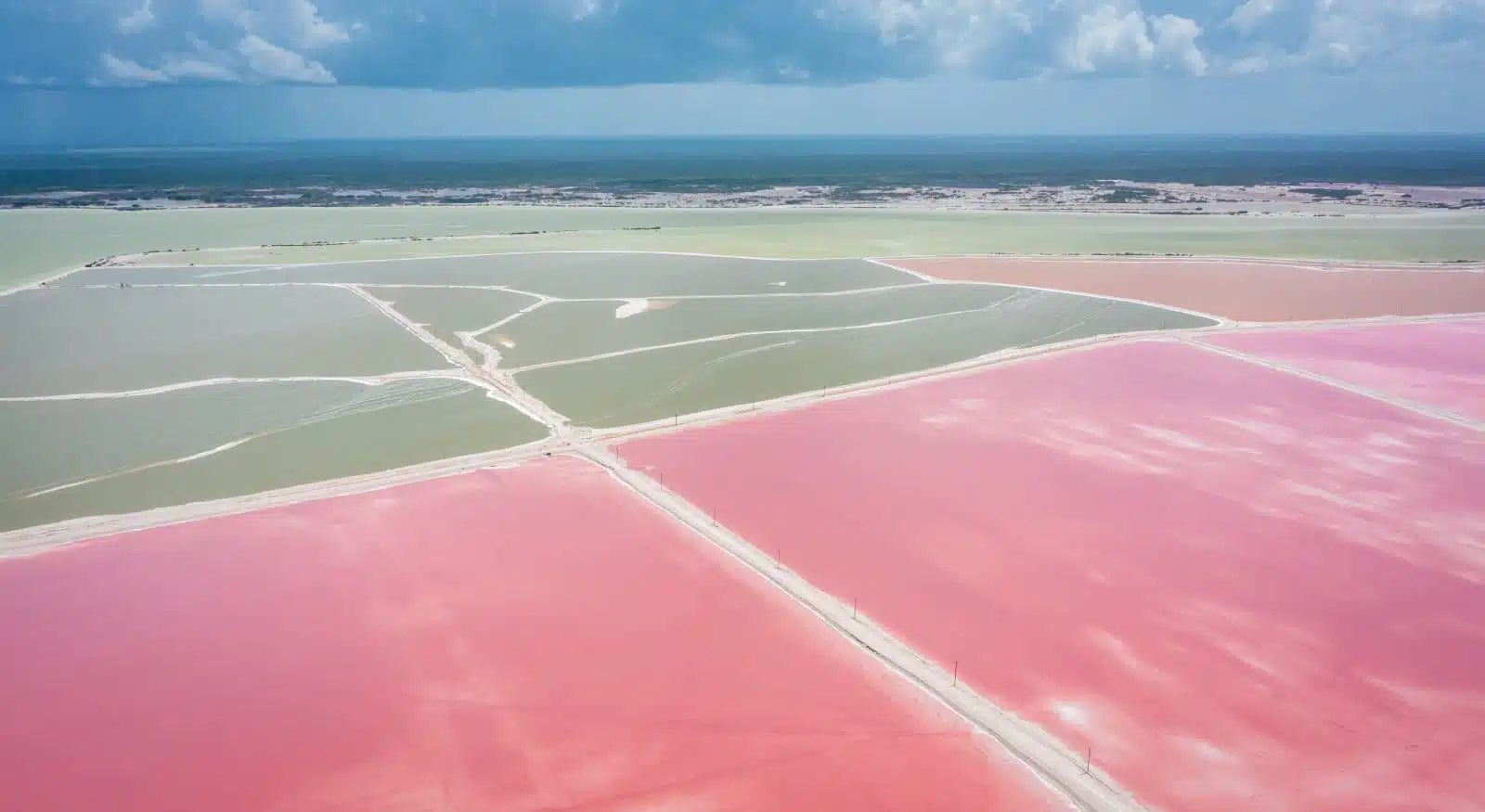
Image Credit: Shutterstock / Alexey Oblov
Las Coloradas, set within the Ría Lagartos Biosphere Reserve, is a series of pink salt ponds that create a striking landscape against the backdrop of the Yucatan’s clear skies and turquoise waters. This small fishing village has gained international fame for its vibrant pink waters due to halophilic microorganisms thriving in the high-salinity environment. The ponds are part of a salt production facility that dates back to the Mayans, blending historical significance with natural beauty. Beyond the visual appeal, Las Coloradas is a testament to the region’s ecological diversity, supporting a range of wildlife, including flamingos and sea turtles. The contrast of the pink ponds against the green mangroves and the blue sky is a photographer’s dream, offering endless inspiration.
Insider’s Tip: Combine your visit with a trip to the nearby Rio Lagartos Biosphere Reserve for a chance to see flamingos, which share the same diet that contributes to the lakes’ and the birds’ pink color.
When to Travel: The Mexican summer months of July and August are ideal, as the intense sun enhances the water’s pink hue.
How to Get There: Las Coloradas is about a 3-hour drive from Cancun. Guided tours are available, combining the visit with other attractions in the area.
4. Pink Lake, Western Australia
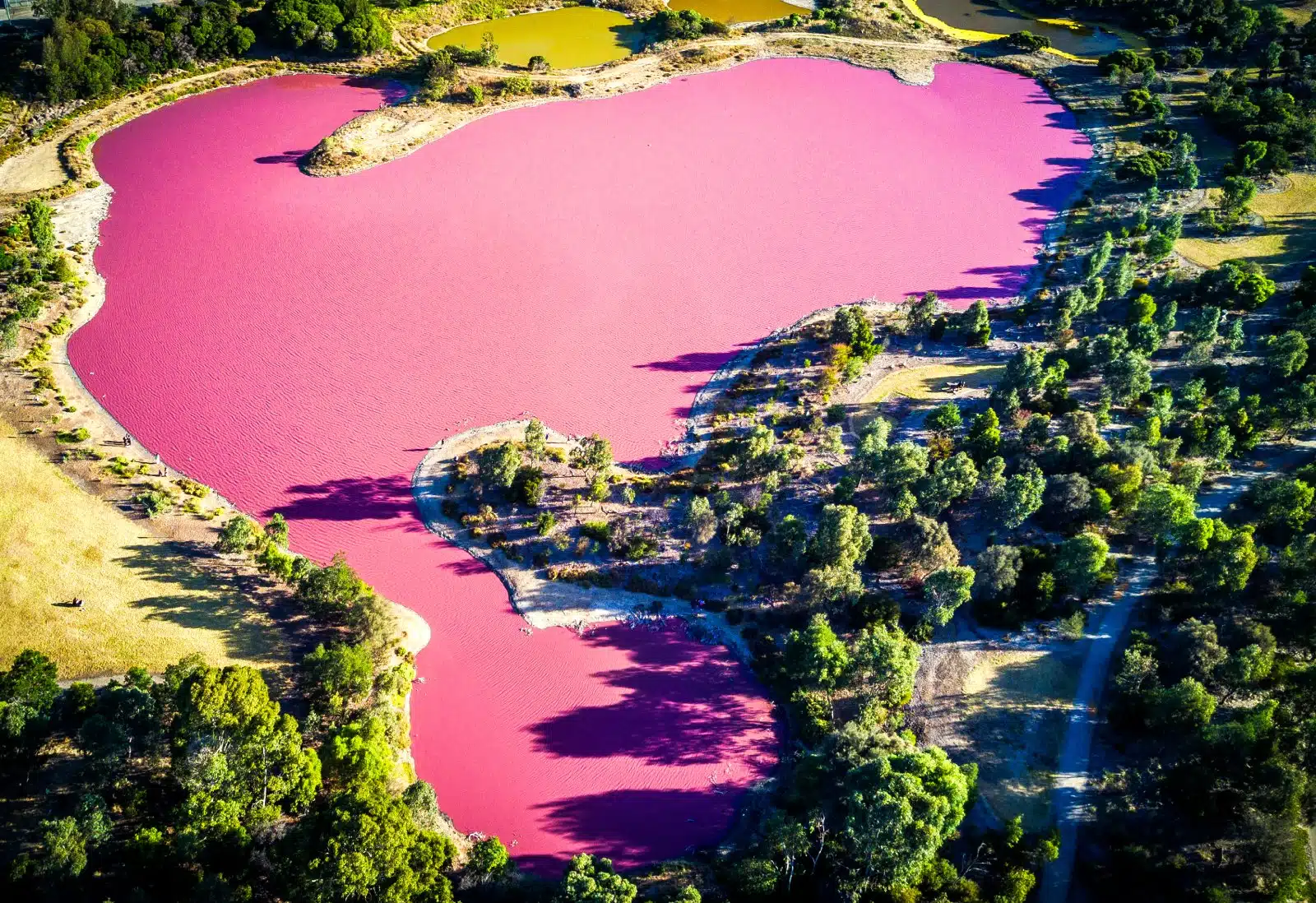
Image Credit: Shutterstock / Nico Faramaz
Not to be confused with its more isolated counterpart, Lake Hillier, Pink Lake near Esperance offers visitors the chance to witness the phenomenon of pink waters from the shore. Situated close to Esperance, this lake is more accessible than many other pink lakes, allowing for closer interaction with its unique ecosystem. The lake’s color can vary with the seasons and time of day, from a soft pink to a deeper hue, reflecting the changing concentrations of algae and salt. Surrounding the lake, the landscape of Western Australia’s south coast provides a rugged contrast, with white sand beaches and wildflower-strewn bushland. Pink Lake is a reminder of nature’s capacity for wonder, easily woven into a broader exploration of Western Australia’s natural beauty.
Insider’s Tip: For a more immersive experience, consider kayaking on the lake to see the pink waters up close when conditions allow.
When to Travel: Visit during the Australian spring or summer (September to February) for the best chances of seeing the lake at its pinkest.
How to Get There: Pink Lake is easily accessible by car from Esperance, with viewing platforms and informational signage available for visitors.
5. Hutt Lagoon, Western Australia

Image Credit: Shutterstock / electra
Hutt Lagoon presents a visual spectacle that varies from pink to lilac depending on the season, time of day, and cloud cover. This large salt lake, located along the Coral Coast of Western Australia, owes its striking coloration to the carotenoid-producing algae thriving in its brine. The lagoon spans approximately 70 square kilometers, offering numerous vantage points for visitors. The contrast of the pink waters against the stark landscape and the azure sky above makes Hutt Lagoon a photographer’s paradise. Beyond its beauty, the lagoon is a significant site for beta-carotene production, used in food coloring and cosmetics. It highlights an interesting intersection between natural wonder and industrial use. A visit to Hutt Lagoon is not just an encounter with a natural anomaly but a journey into a landscape that defies expectations at every turn.
Insider’s Tip: For photographers, the changing colors of Hutt Lagoon present a unique opportunity. Visit at different times of the day to capture a range of hues.
When to Travel: The lagoon is picturesque year-round, but the colors are most vivid from mid-morning to mid-afternoon.
How to Get There: Hutt Lagoon is about a 6-hour drive north of Perth, with scenic flights also available from nearby Geraldton.
6. Salina de Torrevieja, Spain
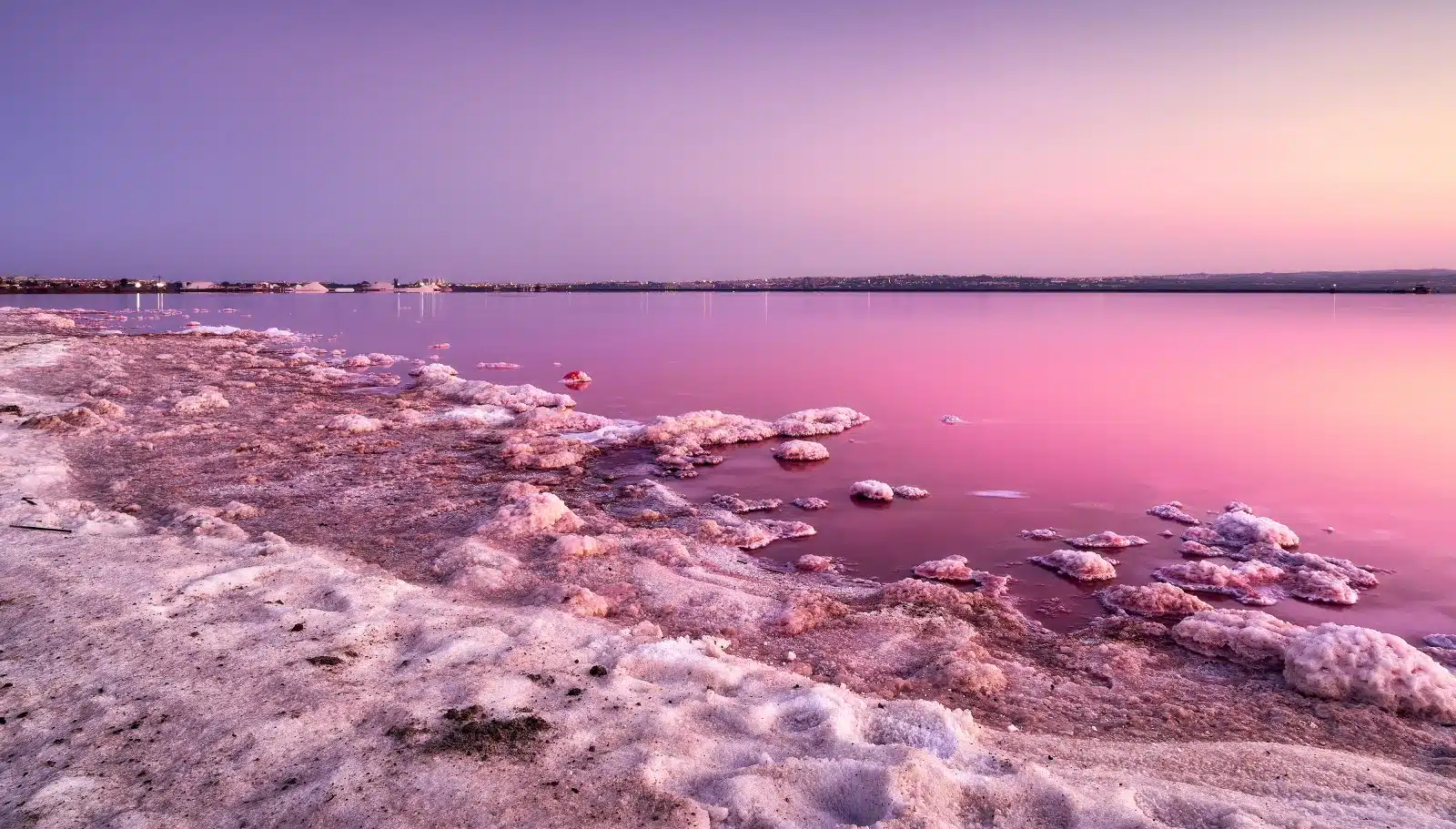
Image Credit: Shutterstock / Helena GARCIA HUERTAS
Salina de Torrevieja, located in Spain’s Alicante province, is one of the few pink lakes in Europe, offering a unique natural attraction against the backdrop of the Mediterranean landscape. The lake’s vibrant pink color is due to the Halobacterium species that flourish in its high-salinity waters, similar to the microorganisms in other pink lakes worldwide. Salina de Torrevieja is part of a natural park that is a critical habitat for various bird species, including the striking flamingos that feed on the same algae and bacteria that color the waters. This interaction between the lake’s biology and its avian visitors creates a dynamic ecosystem where life thrives under extreme conditions. The juxtaposition of the pink lake against the traditional Spanish countryside and the nearby coastal resorts offers a striking contrast and a reminder of nature’s capacity to surprise and delight.
Insider’s Tip: Bring binoculars for birdwatching, especially during the flamingo migration season.
When to Travel: Spring and autumn offer mild temperatures and the chance to see migrating birds, including flamingos.
How to Get There: Salina de Torrevieja is located in the Alicante province and is accessible by car from Torrevieja city, with walking paths and observation areas around the lake.
7. Laguna Colorada, Bolivia
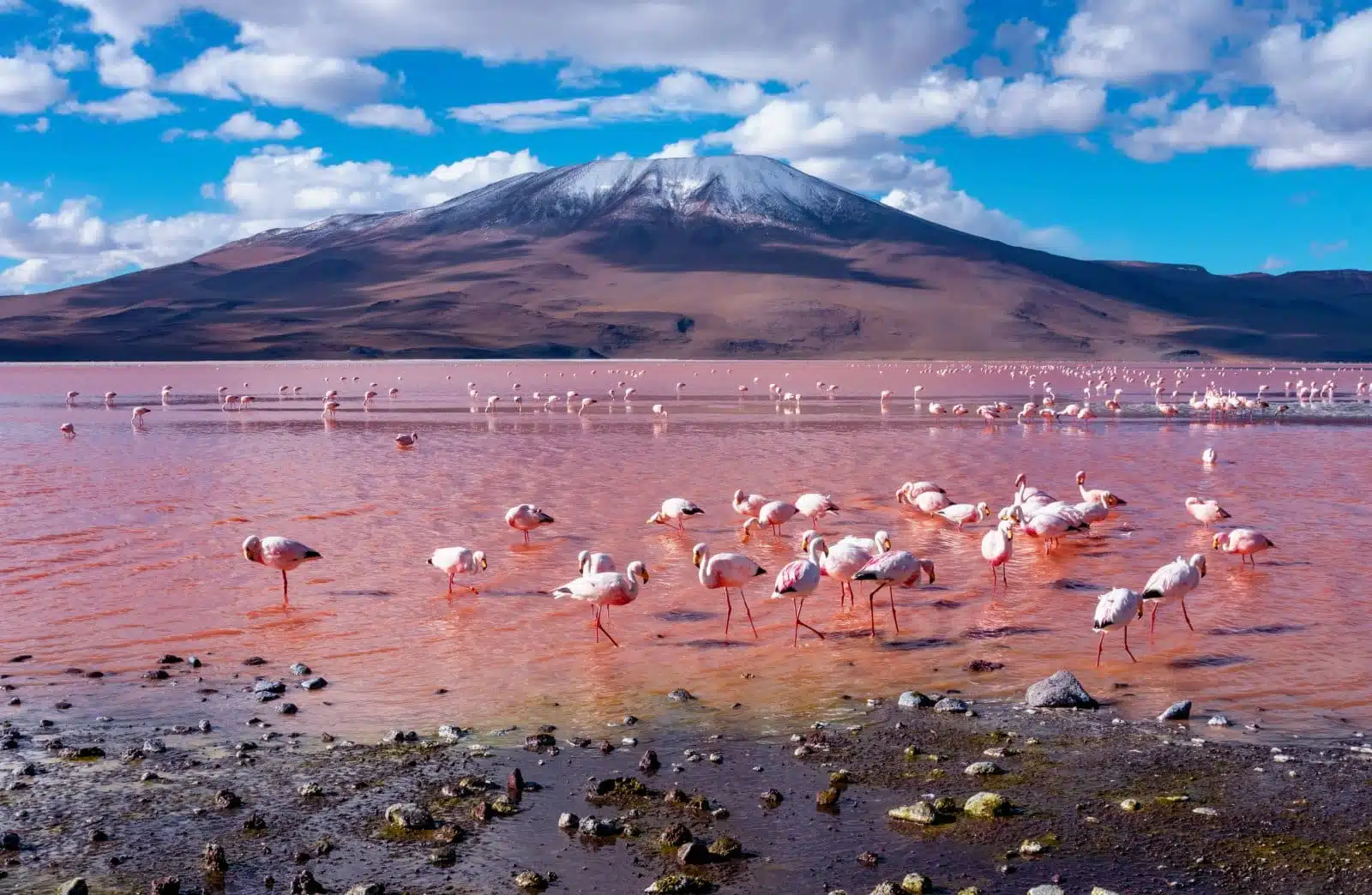
Image Credit: Shutterstock / Belikova Oksana
Laguna Colorada is a shallow salt lake situated high in the Bolivian Andes within the Eduardo Avaroa Andean Fauna National Reserve. Its red-pink waters, dotted with white borax islands, create a surreal landscape that seems more Martian than terrestrial. The lake’s coloration comes from red sediments and algae that thrive in the mineral-rich waters, providing food for the thousands of flamingos that flock to its shores. Laguna Colorada is a key breeding ground for three species of South American flamingos, including the rare James’s flamingo. The stark beauty of the high-altitude desert surrounding the lake, with its geysers, hot springs, and volcanic formations, adds to the otherworldliness that envelops visitors. Exploring Laguna Colorada offers a glimpse into an ancient world where the forces of geology and biology converge to create a landscape of stark, haunting beauty.
Insider’s Tip: Wear layers and prepare for altitude sickness, as the lake sits at over 4,000 meters above sea level.
When to Travel: The dry season from May to October offers clearer skies and easier access to the reserve.
How to Get There: Laguna Colorada is best reached by 4×4 tours from Uyuni or San Pedro de Atacama in Chile, often as part of a multi-day excursion to the Uyuni Salt Flats.
8. Lake Natron, Tanzania

Image Credit: Shutterstock / Bildagentur Zoonar GmbH
Lake Natron in northern Tanzania is a highly alkaline body of water in the shadow of Ol Doinyo Lengai, an active volcano. Its waters can reach pH levels as high as 12, creating a hostile environment where few organisms can survive, except for the alkaline tilapia and the resilient algae that give the lake its red and pink hues. The lake is a critical breeding site for the Lesser Flamingo, which is drawn to the lake’s spirulina algae. The surrounding landscape, characterized by salt flats, volcanic rock, and the imposing figure of Ol Doinyo Lengai, adds to the lake’s dramatic appearance. Visiting Lake Natron offers an adventure into one of the planet’s most inhospitable yet ecologically significant landscapes, where life flourishes against the odds.
Insider’s Tip: The area around Lake Natron offers excellent opportunities for trekking, including hikes to waterfalls and the summit of Ol Doinyo Lengai.
When to Travel: The cooler dry season from June to September is the best time to visit, with less heat and humidity.
How to Get There: Lake Natron is accessible via a challenging road journey from Arusha, with 4×4 vehicles recommended due to the rough terrain.
9. Dusty Rose Lake, British Columbia, Canada
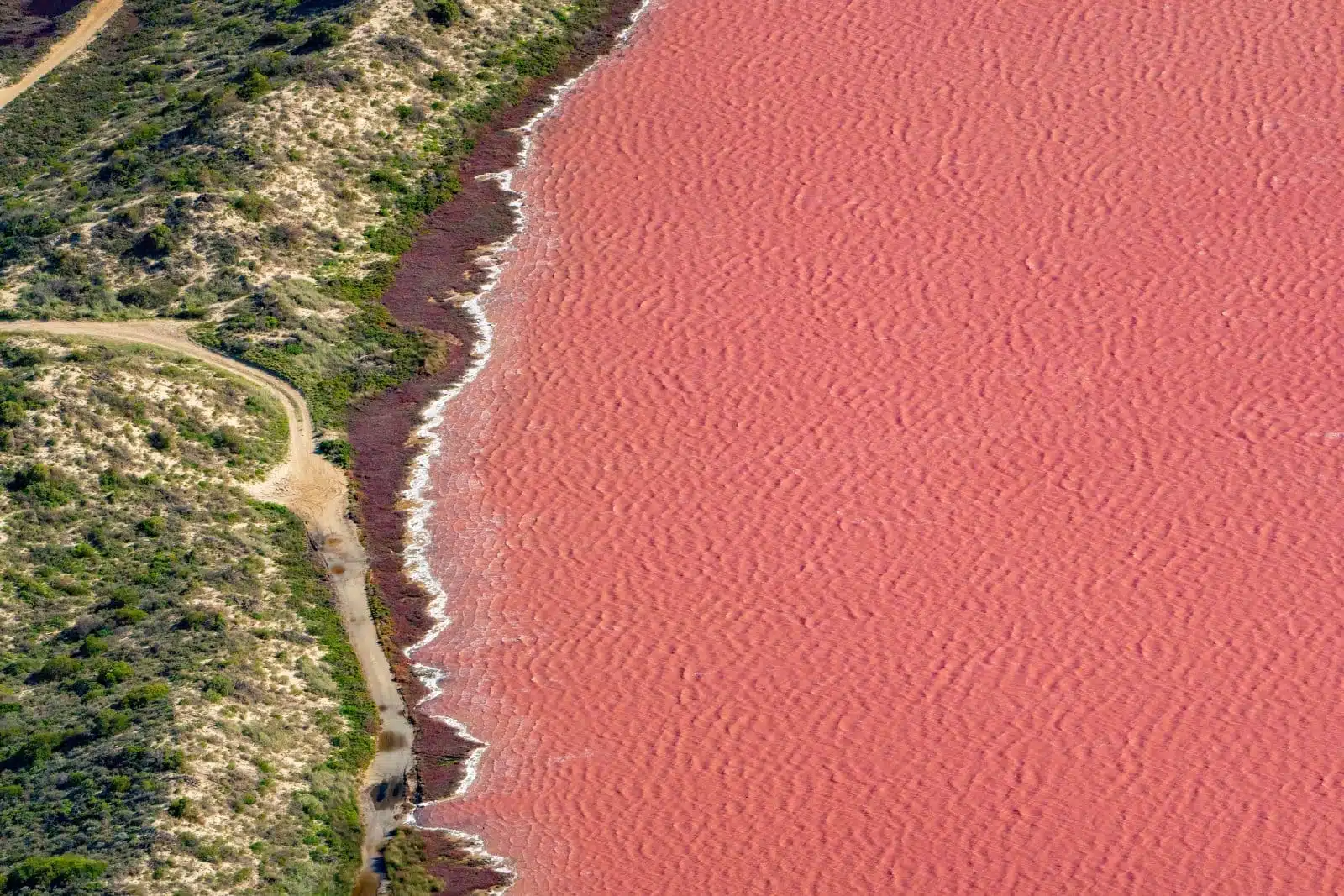
Image Credit: Shutterstock / jenmartin
Dusty Rose Lake in British Columbia is unique among the world’s pink lakes for its coloration, derived not from microorganisms but from the surrounding rock’s mineral content. This remote lake, set deep in the Canadian wilderness, exhibits hues ranging from pink to purple, depending on the light and angle of view. The lake’s isolation contributes to its pristine condition and offers a tranquil retreat for those willing to make the journey. Surrounded by the rugged peaks of the Coast Mountains and dense forests, Dusty Rose Lake is a testament to the geological diversity that shapes Canada’s natural landscapes. A visit here is a journey into the heart of the wilderness, offering a profound sense of solitude and connection with the natural world.
Insider’s Tip: The remote location of Dusty Rose Lake makes it a perfect destination for adventurers looking to escape the beaten path.
When to Travel: The short summer season from July to August is the most accessible time for visiting the remote regions of British Columbia.
How to Get There: Dusty Rose Lake is best reached by floatplane from nearby towns, with local operators offering charter flights into the wilderness.
10. Masazir Lake, Azerbaijan
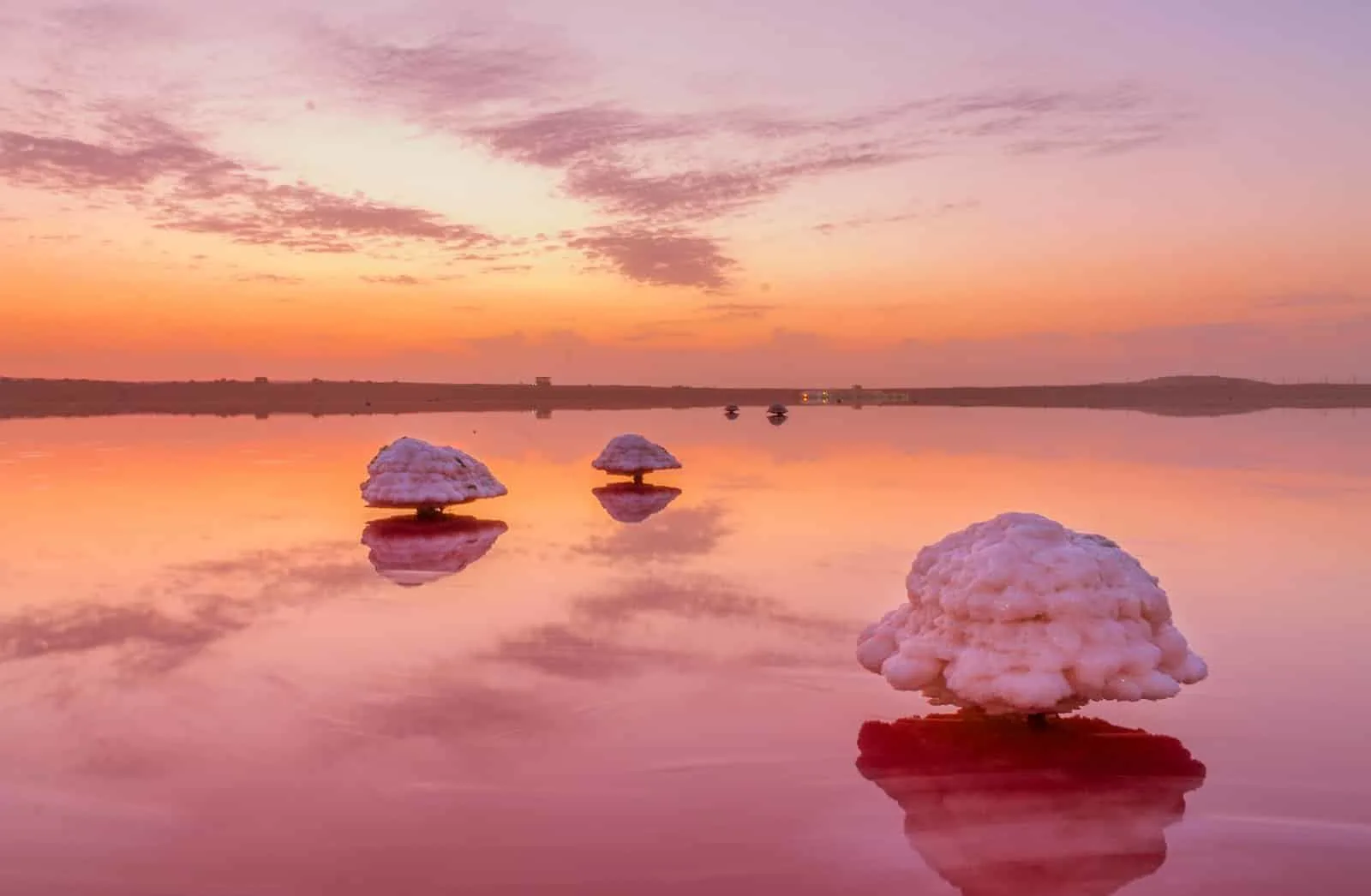
Image Credit: Shutterstock / Bikomins
Masazir Lake, located near Azerbaijan’s capital, Baku, stands out for its striking pink waters amidst the semi-arid landscape of the Absheron Peninsula. The lake’s coloration is due to high concentrations of salt and microorganisms adapted to its extreme environment. Masazir Lake is part of Azerbaijan’s salt production industry. Yet, its unusual appearance attracts visitors and photographers looking to capture its otherworldly beauty. The contrast between the lake’s pink waters and the surrounding industrial infrastructure highlights the intersection of natural phenomena and human activity. Exploring Masazir Lake offers a glimpse into the unique geological and biological processes that can transform ordinary landscapes into extraordinary natural wonders.
Insider’s Tip: Combine your visit with a trip to Baku to experience the contrast between Azerbaijan’s natural wonders and its rapidly modernizing capital.
When to Travel: Spring (April to June) and autumn (September to November) offer mild weather, ideal for exploring both Masazir Lake and the surrounding areas.
How to Get There: Masazir Lake is easily accessible by car from Baku, making it a convenient day trip for those staying in the city.
The Bottom Line
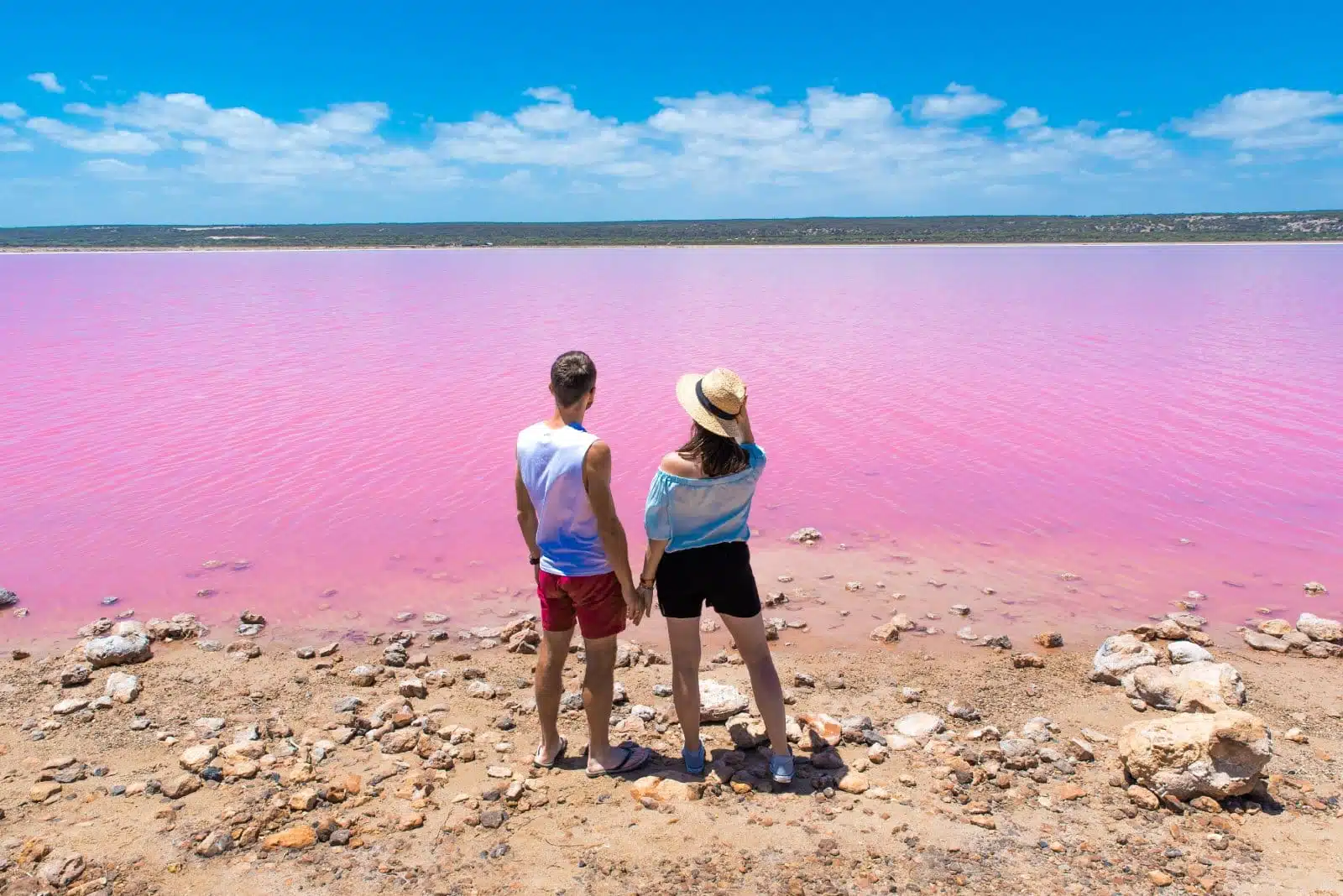
Image Credit: Shutterstock / Damian Lugowski
The pink lakes of the world are a testament to the planet’s diversity and the intricate balance of ecosystems. Each lake offers a unique experience, not just for the visual spectacle but for the opportunity to learn about the natural processes that create such phenomena. Whether you’re a nature enthusiast, a photographer, or simply a curious traveler, visiting these pink lakes provides a glimpse into the beauty and complexity of the natural world. As you plan your journey to these extraordinary destinations, remember to respect the delicate environments that sustain them, ensuring they continue to captivate visitors for generations to come.
More From The Green Voyage
Top 10 Trending Travel Destinations 2024
6 Essential Banking Apps for International Travel – Managing Your Finances on the Go
Traveling With Kids – 10 Tips to Create Memorable Family Holidays
The post 10 Pink Lakes of the World and Why They’re Pink 2024 first appeared on The Green Voyage.
Featured Image Credit: Shutterstock / Damian Lugowski.
For transparency, this content was partly developed with AI assistance and carefully curated by an experienced editor to be informative and ensure accuracy.
Tips for Trip Success
Book Your Flight
Find an inexpensive flight by using Kayak, a favorite of ours because it regularly returns less expensive flight options from a variety of airlines.
Book Your Hotel or Special Accommodation
We are big fans of Booking.com. We like their review system and photos. If we want to see more reviews and additional booking options, we go to Expedia.
You Need Travel Insurance!
Good travel insurance means having total peace of mind. Travel insurance protects you when your medical insurance often will not and better than what you get from your credit card. It will provide comprehensive coverage should you need medical treatment or return to the United States, compensation for trip interruption, baggage loss, and other situations.Find the Perfect Insurance Plan for Your Trip
